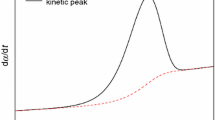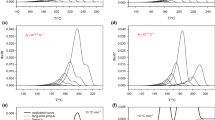Abstract
Based on theoretically simulated sets of kinetic data, the performance of the linear, cubic spline, and Bezier interpolations was tested for single-process kinetic peaks exhibiting different asymmetries. The quality of the approximation of the true thermokinetic background was compared to the (correct) tangential area-proportional interpolation. The Bezier interpolation exhibited the best performance (closest to the tangential area-proportional one); the linear and cubic spline interpolations resulted in a roughly similar level of data distortions. In general, the higher the absolute value of peak asymmetry, the larger the distortions associated with usage of the mathematic interpolations. The most influenced kinetic results were found to be the integrated area of the peak and the actual shape of the peak (being reflected in the kinetic model parameters determined via the model-based kinetic analysis of the data). On the other hand, the model-free kinetic results were found to be in most cases markedly robust with respect to the distortions of the kinetic data associated with the usage of inaccurate interpolations. In particular, the peak-maximum-based methods for evaluation of the apparent activation energy of the process performed extremely well in all cases.







Similar content being viewed by others
References
Šesták J. Thermophysical properties of solids, their measurements and theoretical analysis. Amsterdam: Elsevier; 1984.
Svoboda R. Importance of proper baseline identification for the subsequent kinetic analysis of derivative kinetic data. J Therm Anal Calorim. 2016;124:1717–25.
Johnson WA, Mehl KF. Reaction kinetics in processes of nucleation and growth. Trans Am Inst Min (Metall) Eng. 1939;135:416–42.
Avrami M. Kinetics of phase change I—general theory. J Chem Phys. 1939;7:1103–12.
Avrami M. Kinetics of phase change. II—transformation-time relations for random distribution of nuclei. J Chem Phys. 1940;7:212–24.
Avrami M. Granulation, phase change, and microstructure—kinetics of phase change III. J Chem Phys. 1941;7:177–84.
Höhne G, Hemminger W, Flammersheim HJ. Differential scanning calorimetry. Berlin: Springer; 2003.
Schoenberg IJ. Contributions to the problem of approximation of equidistant data by analytic functions. Part A: on the problem of smoothing of graduation. A first class of analytic approximation formulae. Quart Appl Math. 1946;4:45–99.
Šesták J. Science of heat and thermophysical studies: a generalized approach to thermal analysis. Amsterdam: Elsevier; 2005.
Perejón A, Sánchéz-Jiménez PE, Criado JM, Pérez-Maqueda LA. Kinetic analysis of complex solid-state reactions. A new deconvolution procedure. J Phys Chem B. 2011;115:1780–91.
Svoboda R, Málek J. Applicability of Fraser–Suzuki function in kinetic analysis of complex processes. J Therm Anal Calorim. 2013;111:1045–56.
Vyazovkin S, Burnham AK, Criado JM, Pérez-Maqueda LA, Popescu C, Sbirrazzuoli N. ICATC Kinetics Committee recommendations for performing kinetic computations on thermal analysis data. Thermochim Acta. 2011;520:1–19.
Ozawa T. Kinetic analysis of derivative curves in thermal analysis. J Therm Anal. 1970;2:301–24.
Kissinger HE. Reaction kinetics in differential thermal analysis. Anal Chem. 1957;29:1702–6.
Friedman HL. Kinetics of thermal degradation of char-forming plastics from thermogravimetry. Application to a phenolic plastic. New York: Wiley Subscription Services, Inc., A Wiley Company; 1964.
Flynn JH, Wall LA. A quick, direct method for the determination of activation energy from thermogravimetric data. J Polym Sci B Polym Lett. 1966;4:323–8.
Opfermann J. Kinetic analysis using multivariate non-linear regression. I. Basic concepts. J Therm Anal Calorim. 2000;60:641–58.
Opfermann JR, Kaisersberger E, Flammersheim HJ. Model-free analysis of thermoanalytical data—advantages and limitations. Thermochim Acta. 2002;391:119–27.
Acknowledgements
This work has been supported by the Czech Science Foundation under Project No. 17-11753S.
Author information
Authors and Affiliations
Corresponding author
Rights and permissions
About this article
Cite this article
Svoboda, R. Importance of proper baseline identification for the subsequent kinetic analysis of derivative kinetic data. J Therm Anal Calorim 131, 1889–1897 (2018). https://doi.org/10.1007/s10973-017-6673-x
Received:
Accepted:
Published:
Issue Date:
DOI: https://doi.org/10.1007/s10973-017-6673-x




